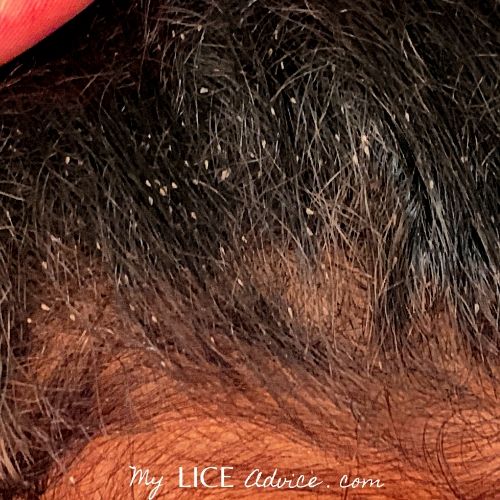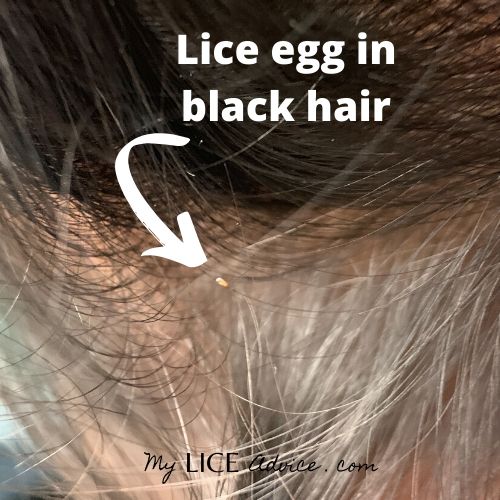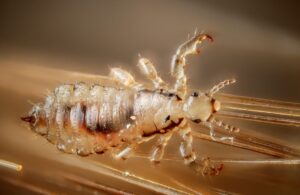Black Lice and Lice in Black Hair
(with Pictures)
Question:
Most websites say that lice are white or tan, but I'm finding black bugs in my child's hair. Can lice be black?

Answer from a Lice Expert:
There is a lot of confusion about the color of head lice. Yes, lice bugs can be black. But there are other bugs that are black that could be in your child's hair as well that aren't head lice. This article is loaded with pictures so you can determine whether those black bugs in your child’s hair are head lice and what it means to have black lice in your hair.

Black Lice vs Lice in Black Hair:
This article is about having black lice in your hair and what it means. If you are looking for an article specific to lice and African-American or Black hair, then you can find a better article here, packed with pictures of lice and lice eggs in Black hair.

Let me introduce myself...

Hi there! I'm a lice expert, lice coach, Registered Nurse, and the creator of My Lice Advice. I help people with lice every day in my lice treatment center, in school districts, and in government work. But the thing I love the most is empowering parents to get rid of head lice in ONE DAY at home!
You can eliminate lice in one day using the same proven professional technique I use in my lice center on your child. Follow along with the Step-by-Step Video System, and when you're done with the videos you're done with lice. PERMANENTLY!

What is Lice?

Lice are tiny insects that live on humans and other species. Human lice require a human host as they need to feed on human blood frequently. They range in size from being almost invisible at birth to about the size of a sesame seed as adults. Three types of lice live on humans: head lice, body lice, and pubic lice.

Body Lice
Body lice are the least common type of lice in the United States and other developed countries. They are associated with poor hygiene and are usually only seen among those living in crowded living situations with limited access to bathing facilities like homeless and refugee camps. If you are someone who bathes regularly, it would be extremely rare for you to have body lice. They live primarily on the clothing and bedding of individuals and only come to the skin when feeding.
Body lice CAN transmit diseases such as epidemic typhus, trench fever, and other bacterial infections.
Pubic Lice
Pubic lice, also known as “crabs,” live in course hair, usually pubic hair. However, pubic lice can make their way into eyebrows, beards, and chest hair. They can rarely infest eyelashes. Pubic lice is an STD and are usually only passed during intercourse.

Head Lice
Head lice are by far the most common type of lice. They are a widespread problem in the United States, where around 12 million kids get head lice every year!
Head lice stick solely to the hair of the head and near the head. You can occasionally find lice in facial hair, but only in severe cases. Head lice are NOT associated with poor hygiene.
Head lice are not dangerous and do not spread diseases, but they often make the person they are infesting uncomfortable.
If, after seeing multiple pictures of lice in this article, you aren’t convinced that the black bugs in your child’s hair are lice, then skip to the Do Other Black Bugs Live in Hair That Are Not Lice? section of this article.
Can Lice Be Black?
Although most websites claim that head lice are tan or white, but that's not true. Head lice are masters of disguise. They are incredibly adaptable and mutate to best survive, including changing their appearance to adapt (they've also mutated to become immune to lice treatments FYI). Below is a picture of REAL LICE that I have pulled off of my clients. As you can see they are lots of different colors.

Tan Lice vs Black Lice

When head lice are first born, they are translucent, almost entirely see-through. The only part that can be spotted easily is their black intestine-looking stomach down the middle of them. At this stage, it is nearly impossible to see head lice. Even if you have fantastic vision, the only thing you’ll see at this transparent stage is a little black dot, which is the stomach of the lice bug.
Head lice on people with blonde hair continue to have a lighter color. Lice at its darkest in blonde hair are usually tan to light brown. The tan color helps them to blend in well with light-colored hair.
Black Lice

For those with darker hair, lice become darker over time (because they are masters of disguise). For a person with black hair, adult head lice usually change dark grey to almost entirely black. Typically the darker your hair and skin color the darker the lice on your head will be.
Comparing Lice Side-by-Side

When you remove lice from the head and put them on a white backdrop, it is readily apparent which lice came from what color of hair. Look at these comparative pictures of head lice from black hair, blond hair, and brown hair.

After Feeding- Darker Lice
Lice are always darker after they have fed. What do they eat? Lice exclusively feed on human blood. Immediately after lice feed, their black stomach becomes larger, and their body becomes darker. Many head lice have a red hue to them shortly after feeding (see picture).

Dead Lice
Regardless of what color lice are while living, they all turn dark brown to black after they die and begin to decay.

Why Is It So Hard to Get Rid of Lice?
Now that you know what you're looking for I want to talk briefly about your biggest worry (that your child actually has lice) and the question I get asked by parents around the world that have been battling lice….

Parents around the world are all asking me the same question…. "Why is it so much harder to get rid of lice now?"
Lice have become immune to everything that used to work in the past. Perhaps you remember your mom using a typical lice treatment or mayonnaise and that doing the trick. The new strain of head lice is no longer killed by those treatments, that’s why lice today are termed by people, “super lice,” because they are immune to those treatments.
I’ve cured thousands of people of lice in my lice center and let me tell you, I don't do it with over-the-counter lice treatments.

Most people struggle with lice because they focus all of their attention on killing lice bugs and not enough attention on GETTING RID OF LICE!
If you want to get rid of lice you have to address all 3 of the problems of lice:
- Lice Bugs
- Lice Eggs
- Getting Lice Back
The best way to get rid of lice is to tackle all 3 of these problems at the same time, which is what I teach in my step-by-step video system.
So, if you discover your child HAS lice, don't panic. Just head over to the video system. Follow along with the videos and you'll be done with lice by the end of the day.


What Does Lice Look Like in Black Hair?

If you are African American or have afro-textured hair, be sure to check out the article Black People Get Lice Too: Pictures and Treatment Tutorial that shows detailed pictures and has a tailored treatment plan for denser hair.

Head lice range from almost invisible at birth to the size of a sesame seed when fully grown. They range in color from tanish grey to brown and are slightly translucent, but in black hair expect to find black, dark grey, or dark brown adult lice. The defining characteristics of head lice are:
- 6 legs attached to the upper ⅓ of body, not on the large abdomen
- No wings
- Adult lice: expect darker adult head lice in dark hair- they will be dark brown to black.
- Smaller, younger head lice (nymphs) will be a very translucent tan with a dark intestine-like stomach.
- Black stomach/intestines often visible through their translucent body (larger after feeding)
- Antennae
- Tapered/ claw-like legs
If, after seeing lots of lice pictures, you are convinced that the black bugs you are finding are not head lice, then skip to the Do Other Black Bugs Live in Hair That Are Not Lice? Section of this article.
Do Other Black Bugs Live in Hair That Are Not Lice?

Fleas
If you have pets, then there is a chance that you can find fleas in your child’s hair. It's not typical that a child would have a “flea infestation” because fleas do not prefer humans. But, I have found fleas in several children over the years. I end up treating those children with fleas in the same way as I treat head lice- with a super lice treatment.
You can tell the difference between fleas and lice because fleas have hind legs that jump, whereas head lice do not jump and do not have hind legs. Head lice’s legs are all on the upper half of their bodies.
Bed Bugs
One other type of bug that could be in a child’s hair is bed bugs, although bed bugs do not infest hair. Bed bugs typically live the bed, and in furniture near the bed. They usually only come out to feed at night on the skin, not in the hair.
You can tell the difference between head lice and bed bugs because bed bugs are very flat with a shield-shaped body.
Lice Eggs (Nits) in Black Hair

Because lice are so good at hiding and moving quickly, it is pretty rare to see lice bugs early on in an infestation. Instead of looking for fully grown lice bugs, you should focus on finding lice eggs (also called “nits”) in the hair.
Unlike adult lice bugs, nits do not move around or hide. These eggs are glued onto the hair strand so they will not fall off. Because nits in your child’s hair are the first sign of a lice infestation, finding them at this stage can help you eliminate lice when there are only a few adult lice bugs.

Lice lay 6-10 of these nits in the hair every day, and they add up quickly. Nits are often mistaken for dandruff or dirt in the hair because they are small, and their shiny appearance can make them look white. In black hair, most lice eggs will look white and shiny or light brown.
There are 7 main differences between lice and dandruff, some of the main differences are that nits stick to the hair strand, are tear-drop shaped, and vary in color from translucent to almost black. The tell-tale sign of lice eggs is that they attach to the hair strand using glue, they will not flick, blow, or brush off.
How Do I Check for Lice In Black Hair?
The best places to look for lice eggs are in the “hot spots” of the head: behind the ears, the nape of the neck and the crown of the head.
Checking for lice eggs in the “hot spots” of the head, section by section, is the best way to determine whether someone has lice in the early stages. Here’s a link to a full tutorial on how to check for head lice. This tutorial features a blonde child, but the principles for checking for lice are the same.

Are Super Lice Black?

Regular head lice and super lice look precisely the same so that they can be any variety of colors, including black. Super lice and regular head lice are virtually the same bugs, except super lice has mutations that make them (and their eggs) very difficult to kill. These super lice are becoming the “new” strain of head lice.
Over 98% of all head lice are super lice (studies here). So, if you're dealing with lice then you're most likely dealing with lice. These lice are immune to traditional home remedies and over the counter treatments. The best way to get rid of super lice is by doing a professional lice treatment. You can pay big bucks to go to a lice professional or you can learn how to do a professional lice treatment at home using my step-by-step video system.
The Never-Ending Cycle
Most people that use lice kits and home remedies get caught in the horrible "Never-Ending Cycle of Lice"

First- You Have Lice

When you first discover lice you have adult lice bugs, baby lice bugs, and lice eggs (also known as nits)
You Think You've Gotten Rid of It.
But...

After using an over-the-counter treatment or a home remedy, people think they've taken care of the problem because they aren't finding lice bugs for a while.
But the bigger problem is the lice eggs that are left in the hair. Lice kits and home remedies don't kill eggs, and each of those little lice eggs has a bug inside just waiting to hatch and re-infest your child again.
Then- Those Eggs HATCH!

Just like lice eggs are tiny, when lice first hatch they are teeny-tiny. In fact, they are almost invisible to the naked eye! So, it typically takes a few weeks for them to grow big enough for you to see them.
And by the time you notice your head is infested all over again!
And Lice Is Back Again!

How to Avoid the Never-Ending Cycle
If you want to avoid this never-ending cycle and get rid of lice fast then check out my Step-by-Step Video System. Follow along with the videos and you can be completely done with lice in ONE DAY, no retreatments necessary.
How to be lice-free by the end of the day...

GET THE VIDEO SYSTEM
Get rid of lice the same way the experts do. Your personal lice coach walks you through each step of doing a professional lice treatment at home in a series of videos.

FOLLOW ALONG
Follow along with the videos on your child in your home. No lice kits or toxic chemicals involved!

BE DONE WITH LICE!
When you're done with the videos, you're done with lice. And it's gone permanently!
Summing It Up...
If you are finding black bugs in your child’s hair, you are almost certainly dealing with head lice. Although many internet sources without a lot of hands-on knowledge will say lice are tan or white, lice can be a variety of colors. Lice typically blend in with the skin and hair color of those that they are infesting.
Regardless of what color of lice you are finding in your child’s hair, you are likely dealing with super lice. Super lice are incredibly resistant to the old treatments we used 30 years ago. The fastest and most effective way to get rid of lice is doing a professional lice treatment at home, which is what you'll do with the My Lice Advice Step-by-Step Video System.
All the best,


Theresa is a Registered Nurse and lice expert with years of experience curing children of lice. She owns a lice treatment center in the US which is where she perfected the Step-by-Step Video System proven to get rid of lice. She also works with government agencies and schools helping those with the worst head lice cases in America.
Her greatest passion is empowering parents by teaching parents online how to do a professional lice treatment on their child at home. She is the Lice Coach for the My Lice Advice Step-by-Step Video System.


